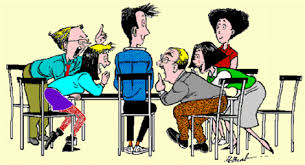I'd like you to look back at your past experiences as a student. What were the best memories you had about those classes?What could you do to recreate them in your classroom?
Personally, my best memories are the ones where I had the most fun. When the teacher thought outside the box and did something different and challenging for a change. It wasn't so much the activities, but more about the innovative approaches to teach that activity: games, movies, active practice, creative essays, special projects, class debates, etc....
Being a good ESL teacher has become more challenging due to the enormous amount of apps created to learn. I know I use them all the time, I search for fun and creative ways to learn new things, use them for inspiration. However, apps can only take you that far, apps are great and are an essential way to complement your learning, but after a while you get tired of using it because it is always the same, the key ingredient is missing: debates. You can't argue with a computer, you can't share and compare opinions with it. That is why "real " face-to-face classes are needed because we feel the need to socialize, to converse with others. Anything and everything that gets two or more people debating about something is, what I call, a "perfect ESL conversation". How do we achieve that conversation? Where do you get the inspiration to find your topics? Your teaching material?
Nowadays, we always do a little research online or watch T.V., listen to the radio, read newspapers, magazines, books, until we find the most fitting topic. There is really no good or bad way to find inspiration. Whenever I have any spare time I read about anything, and if I see something that I like I mark it down, that way I don't forget it, plus it saves you time for your next activity research.
Next step, you have your topic, are your students going to like it? Will they have enough knowledge about it to have a long and deep debate about it? Do they have the vocabulary to enter that specific ESL conversation? Not always. Starting with a guided brainstorming activity could make the students feel more confident and inspired to participate. Make it a game, introduce all the related vocabulary you can use for this activity. If it's possible, teach both formal and informal, try different accents, use approved material for your classes. In order to have a complete lesson, you will need to make sure the students know what the topic is about, for that you will need to warm them up with the brainstorming, followed by a pre-selected short text (even short proverbs will do the trick), images, sound or video related to the subject, and an activity to help them participate and discuss the matter. Don't get freaked out if the conversations starts to drift from its original course, as long as the students are discussing and engaged you have fulfilled your main goal. Challenge your students to use all of the vocabulary you previously worked on and praise them if they achieved it. Preparing a good class means to prepare a variety of materials. These materials will be what turn your class from an O.K. class to an unforgettable one, allowing you to adapt each class for different kind of students.
Being a teacher for
Oxbridge has taught me that there are a lot of different kinds of people, with different backgrounds, motivations, goals, and ages. Students with different learning styles (auditory, visual, kinesthetic) some that will discuss to almost anything and other that are not so keen on participating. Some classes will definitely be more difficult that others, but if you are well prepared you should be just fine.
In conclusion, it is always better to think outside the box, be as innovative as you can and always prepare your material for different kind of scenarios. MOST IMPORTANT, remember to have FUN!
